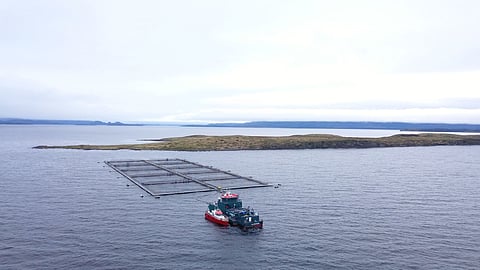

Cermaq's farm in Chile. Following the court's decision, the company will have to pay a fine of CLP 3,328,050 (EUR 3,244 / USD 3,516).
Photo: Cermaq Chile.
The Fourth Chamber of the Chilean Supreme Court unanimously rejected the appeal filed by Cermaq Chile and upheld the fine imposed on the salmon company for violating the ISA (infectious salmon anemia) virus control regulation in one of its farms located in the Aysén Region, in the south of the country.
The total fine amount is 50 UTM (Monthly Tax Unit, a tax measure used to pay certain credits which amount is determined by law and updated monthly). In Chile, in October 2024, this fine is equivalent to CLP 3,328,050 (EUR 3,244 / USD 3,516).
The complaint dates back to December 2019 when inspectors from Chile's National Fisheries and Aquaculture Service (Sernapesca) detected shortcomings in the Health Surveillance and Control Program for Infectious Salmon Anemia.
This regulation contemplates that a salmon farming site in the ISA virus suspect category must increase its sampling frequency. However, according to Sernapesca's information, this did not occur in the case of Cermaq Chile's Tránsito farming site.
"If the center is notified as suspicious, it was appropriate to sample all the units of the center and not only five of the eight cages as was done," explained the Regional Director of Sernapesca Aysén, Daniela Leiva.
Chile's National Fisheries and Aquaculture Service pointed out that, although sampling is carried out by certifiers external to both Sernapesca and the salmon producer company, it is the latter that must establish supervision mechanisms when notified that it is a suspicious site.
Specifically, the Court's ruling established that "the minimum diligence that is incumbent upon it as holder of the authorization that allows it to operate a farm site implies that it must ensure and provide all the necessary means for the observance of the regulatory requirements, especially when these are related to the health management of the concession linked to High-Risk Diseases such as the ISA virus."
The regional director of Sernapesca in Aysén acknowledged that "in this case, there was also an error on the part of the Health Condition Certifier and the ETECMA Laboratory." Therefore, Daniela Leiva called for absolute responsibility for their work to all authorized entities in this process.
"These are diseases that can have serious impacts on economic activity, a decrease in economic income, and, of course, can cause environmental and health damage of great dimensions in the marine ecosystem," warned the head of Sernapesca in Aysén.
Infectious salmon anemia is a high-risk disease that affects salmon, particularly Atlantic salmon. To monitor the status of the ISA virus in Chilean farms, Sernapesca has a specific surveillance and control program and mandates that companies carry out periodic sampling to detect the presence of the virus in their sites.
Chile's National Fisheries and Aquaculture Service pointed out that this surveillance, and its compliance by the salmon-producing companies, is the main input for taking timely measures in the event of virus detection and warns that non-compliance represents a high health risk.
Although the Salmon Farming Health Report 2023 published by Chile's National Fisheries and Aquaculture Service last month highlighted that the country had recorded only one outstanding outbreak of ISA in 2023 - a standing statistic, especially compared to the news in other producing countries - Sernapesca does not want to let its guard down.
The Chilean aquaculture authority recalled that the crisis caused by the appearance of ISA in 2007 cost the country USD 3,500 million (EUR 3,227 million), 15,000 jobs, and a reduction of 25 points of the GDP of the Los Lagos region, the second largest producing area in the country after Aysén.
